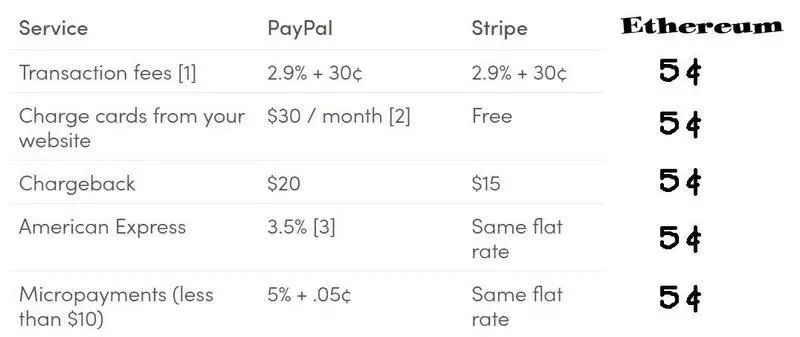Viewpoint | The value of Ethereum as a payment platform
Author: Tyler Durden
Translation & Proofreading: Min Min & A Jian
Source: Ethereum fans
In a previous article, I have pointed out the problems in these hot areas of payment. On the one hand, investors underestimated the subversive threat of stable currency in the field of financial technology, and on the other hand overestimated the current business model of proprietary networks. In today's article, I want to emphasize that the same problem with coin investors is that they underestimate ETH.
- urgent! BitMEX "accidentally" leaked a large number of user email addresses, please replace them immediately
- Investor Perspectives | System, Order and Privacy Protection: Another Perspective on Blockchain
- The private key is handed over to relatives and friends for safekeeping. Are you assured of such a deposit?

As more and more stable coins are built on Ethereum, Ethereum has gradually become a legal currency payment platform . Tether has moved the $4 billion USDT from the Omni agreement to Ethereum. Several other mainstream stable currencies also belong to the ERC 20 currency, including the stable currency issued by the new currency. Then there is DAI, the first de-centered digital dollar to be censored. Although the stable currency is still in its infancy, its quarterly trading volume has surpassed Venmo.
“French currency on the blockchain” It is only a matter of time before it becomes mainstream payment power. Yes, these stable currency products are indeed rough and immature, and the networks on which they depend are also inefficient and expanding. However, every type of payment has encountered such problems at the beginning of its rise. The focus is on its future development potential, and the stable currency has a very broad prospect, because an open network can always break the limits.
The first difference is the diversity of choices. If users on Ethereum want to pay with stable currency, there are many options, and they can choose to transfer money through a variety of wallets. Competition between stable currencies will lower prices (close to zero) and improve service quality. On the other hand, PayPal only provides a wallet and payment channel, so the second difference lies in the handling fee.

Paying $1,000 online via PayPal requires a $30 fee. If you pay with a stable currency on Ethereum, the cost of the payer will not exceed 30 cents . All traditional payment gateways, such as Stripe, Square and Adyen, also charge a high fee. The reason is still the business model. By charging such a high fee, payment service providers were able to take a large piece of cake from the retail industry. Stabilizing coins is a disruptive solution.
There are huge differences in the economic model between the two. The traditional means of payment is based on the amount of money transferred from the transfer amount, and the stable currency maintains the operation of the network by charging a fixed fee. In Ethereum, whether it is a transfer of $50,000 or $5, you only need to charge a few cents. If you transfer $50,000 on PayPal, you have to pay for a month's rent. It can be seen that the stable currency movement has greatly changed the charging mode of the payment industry. All along, we have been proportionally based on the amount of the transfer, and will be converted into a fee based on the network congestion.
Traditional payment service providers (and related investors) deserve a lot of praise. However, we call them payment gateways for a reason. Gateways are restrictive to users and costly, and can bring huge profits to their owners – until the day when new technologies are eliminated. Communication gateways (also known as telephone companies) were once the world's most absorbing companies, providing services on a per-minute basis (followed by each text message), but they came to the end after the rise of the Internet. . After the rise of the blockchain, the proportional industry's fee-based charging model will face the same fate.
At present, it seems that the profiteering of the payment industry has created an opportunity for the stable currency, and the mainstream stable currency is built on the Ethereum. In this situation, investors overestimated the equity of the payment service providers they held and underestimated the value of ETH. The market value of all traditional payment service providers has combined to reach about $1 trillion. Ethereum – currently the fastest growing legal currency payment platform in the world – can achieve $100 billion even if it has a 10% market share, ie, $1,000 per currency.
That's right, traditional payment companies offer not only money transfer services, but also other great services. The same is true of Ethereum, and in theory, such a programmable platform can do better at a lower cost. For traditional payment channels, the issuance of rewards and tickets needs to be implemented through another system, which is very difficult and costly. These can be achieved with only a few lines of smart contract code on Ethereum. However, there is a stronger argument behind the view that Ethereum can become a mainstream payment platform, that is, liquidity.
Now imagine that as you read this article, I have transferred a $10,000 stable currency to your usual wallet. After getting the money, you can redeem another currency on the decentralized exchange, and then take the converted currency to the Compound's currency market to lend to earn interest. Then you take out the earned interest, get another exchange to buy ETH, use this ETH to gamble on the next election, you can also take insurance, or token-based real estate. All of these operations are done on the same network and on the same wallet, and can be done for a few cents.

I think you should not repeat the same process on any or any of Visa, PayPal, ACH, Transferwise, Square Cash. And even if you wait a week, it costs 10 times the fee, and it will not be 1/10. The real reason why Ethereum is expected to become a payment platform is that it can convert payments into a small (low-cost) data transmission, on which users can access a new native digital super fluid financial system. If, as a payment platform, the value of Ethereum only accounts for a small part of the total value of the entire payment industry, then as a new value agreement, Ethereum is worth the whole world.
(Finish)
We will continue to update Blocking; if you have any questions or suggestions, please contact us!
Was this article helpful?
93 out of 132 found this helpful
Related articles
- Preparing for the main online line: a quick overview of Libra node operation guide
- Jianan past events: floating up and down eight years, or become the first mining machine stocks
- Take Ripple Coin (XRP) as an example to understand how big the international cross-border remittance of blockchain is.
- QKL123 market analysis | short-term V-shaped rebound, the market fell slightly (1101)
- Coinbase: The number of Bitcoin users in the US has reached 27 million
- Goddess, KOL, Super Awards – Wuzhen, Babbitt and "TA" friends are coming!
- Intercontinental Exchange CEO: Bakkt is talking to major financial institutions to explore the possibility of adopting its Bitcoin derivatives






